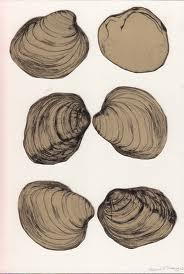The Pittsburgh Post Gazette published an article on the Dunkard fish kill on July 17th, summarized below:
The stench of death is always a signal that something has gone terribly wrong, and it became overpowering as artist Ann Payne approached Dunkard Creek in 2009. An art exhibition, brimming with wonder but underscored by sorrow, is testimony by 90 artists to what she saw.
“Reflections: Homage to Dunkard Creek” commemorates the thousands of living things that died when coal mine wastewater changed the chemistry of the waterway, producing a golden algae bloom. All gill-breathing organisms — fish, rare populations of mussels, amphibians — suffocated.
The exhibition of 90 “portraits” of a variety of creatures in a variety of media is at the Art Institute of Pittsburgh, Downtown, through Saturday. It will next travel to Maryland and West Virginia.
Over its 43-mile length, Dunkard Creek wends several times across the Mason-Dixon Line separating Pennsylvania and West Virginia before emptying into the Monongahela River near Point Marion. Ms. Payne, a scientific illustrator who lives in Morgantown, was made aware of the fish kill by a friend who lives on the stream.
“As we walked down to the creek, we noticed a disturbance to the left and saw a strange grouping of birds including usually shy wading birds like green herons. They were picking at fish bodies that had washed up on the shore.”
Wearing borrowed waders, Ms. Payne entered the water.
“It was horrible. Everything was dead. There were big fish, little fish, every kind, floating slowly in the low water. You could see how they struggled. Their mouths were open as though they had been gasping. Their gills were bleeding.
“I grew up in West Virginia and my best friends were salamanders. They’re very shy, ugly. They died trying to crawl out of the creek. They would never do that. Little fish were trying to get up into the little seeps along the shore, but there wasn’t enough water. They tried until they died. “I was just stunned. I didn’t believe what I was seeing,” Ms. Payne said.
Ms. Payne considered an appropriate response and, being an artist, she began to depict each of the species that had died, a kind of visual litany.
“The inception of this [project] was my amazement at how something this catastrophic can happen right here and yet people weren’t owing it. You have to be a witness to something. Most people are kind-hearted. You have to get their attention. Then I think people’s hearts would be open.”
By the end of 2010, she had made about 10 paintings. “At age 70, I realized it would take me a lifetime to finish.” That’s when she began recruiting artists.
She received support from the Appalachia Program division of The Mountain Institute, a global nonprofit that, according to its website, “empowers communities in the world’s great mountain systems through education, conservation and sustainable development.” The institute also funded a 25-page full color catalog that illustrates each artwork and provides background on Dunkard Creek. The catalogs are free to exhibition visitors.
Ms. Payne wasn’t sure about how to recruit artists, or even which to approach. One qualification was that they had to have a tie to the Monongahela Watershed. “We live here, work here, grew up here, study here, and/or vacation here. The watershed is literally a part of each one of us,” she wrote for the catalog introduction.
Ms. Payne’s entry is the Fowler’s toad (Anaxyrus fowleri), its depiction reflecting her training in and years of experience as a scientific illustrator:
Did she have a special attachment to the toad? “Well, when we were growing up we had a toad living under our porch.”
But Ms. Payne is clearly attached to all of these creatures, from Mr. Donoughe’s Variegate darter, a fish, to Pittsburgher Sharon Arffa’s Pistol grip, a mussel proposed as endangered in Pennsylvania, to the tiny Green stonefly by Nancy Maunz of Clarksburg, W.Va. Media includes paint, graphite, pieced wood, fiber and pencil shavings.
Each artist researched his or her own animal, and they all learned by it. For example, several mussels have developed specialized relationships with fish to complete their life cycles. The Snuffbox mimics the rocks that darters, sculpins and log perch root in when feeding. When the fish approaches, the mussel clamps down on its “nose” and holds it while injecting larvae into the host’s gills.
The exhibition is “a modern-day cautionary tale for Appalachia’s waters,” Appalachia Program director Brent Bailey wrote in the catalog, “told through the images of 90 species who once called the creek their home. This heartbreaking and true story of a collision between the energy industry and natural resources is also about ‘us’ — all of us who have a stake in our water.”
In what must be a nightmarish replay for all of the project participants, the lower 5 miles of Dunkard Creek have again been polluted with high levels of total dissolved solids, the Post-Gazette’s Don Hopey reported Saturday. The TDS concentrations were caused by a combination of low stream flow due to drought conditions, abandoned mine discharges and the discharges from Dana Mining’s Steele Shaft treatment plants, he reported. The Department of Environmental Protection prognosis is that the levels will worsen before they improve.
“Reflections” continues at 420 Blvd. of the Allies, Downtown, through Saturday. Admission is free. Hours are 9 a.m. to 8 p.m. today and Thursday, 9 a.m. to 5 p.m. Friday, and 9 a.m. to 4 p.m. Saturday.
The exhibition will travel to the following venues: Aug. 1-22, Frostburg State University, Md.; Sept. 7-Oct. 5, Parkersburg Arts Center, W.Va. November dates to be announced, National Conservation Training Center, Shepherdstown, W.Va.; and Jan. 4-March 8, 2013, Carnegie Hall, Museum Gallery, Lewisburg, W.Va.
See also the home web-site for the “Reflections” art project.
The Dunkard Creek Restoration Plan of the WV Division of Natural Resources can be found here.

